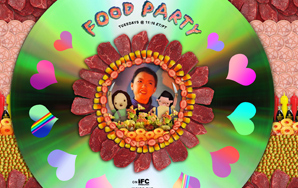Food Party: Requiem for the Best TV Show Ever Made
Food Party was a combination of Pee Wee Herman, Salvador Dali, Julia Child, Tim and Eric, and LSD. To call it a cooking show would be like calling The Wire a cop show. Episodes revolved around hostess (and show creator) Thu Tran cooking up some weird food in her Technicolor cardboard kitchen.
By Brad Pike

In October 2010, Thu Tran announced that IFC, in possibly the most foolish decision ever made by a television network, had not renewed Food Party—inarguably the greatest TV show ever made—for a third season. Why am I writing about this now? Well, I didn’t learn about the cancellation until a few days ago when I checked the internet to see when the new season of it would premiere, and to my horror, I discovered that I had been living my life in blissful ignorance, operating as if Food Party was still in production.
Food Party was a combination of Pee Wee Herman, Salvador Dali, Julia Child, Tim and Eric, and LSD. To call it a cooking show would be like calling The Wire a cop show. Episodes revolved around hostess (and show creator) Thu Tran cooking up some weird food in her Technicolor cardboard kitchen. Some of those foods included koala tofu, white tiger apples, yin yang yam yak, zit butter, pornkey (pork and monkey hybrid), duck blood dip, and, of course, human flesh. The show presented some profoundly surreal storytelling with plots that gleefully bent logic to the breaking point—giant talking rats, magic strawberry spitting, and floating pandas. Further adding to the sense of utter snafu, no two episodes were alike. There was no formula for viewers’ minds to latch onto, little coherence, and no predicting what might happen from one moment to the next. In one episode, Thu was a vampire. In another, she was a mother of three. In another, she was a princess. It’s a fine line between a bunch of random shit and inspired surrealism, and Food Party teetered precariously on that line week after week without ever quite toppling.
From an artistic standpoint, the show was a visual feast. Everything, absolutely everything was handmade from the kitchen walls to the cereal boxes. Even the flames on the stove were just hands wearing yellow gloves, wiggling their fingers. The sheer volume of puppets, paintings, props, costumes, and backgrounds is unbelievable. I was simply flabbergasted by the collective ingenuity on display. All the show’s creators and writers were previously artists and illustrators, and it shows. Thu Tran herself majored in glasswork, but specializes in what she calls “weird psychedelic artificial whatever landscape.” The show started out on youtube, garnered attention from metafilter, blogs, and finally IFC, which picked it up for six ten minute episodes. Who would’ve guessed that the way to make an awesome TV show was to get creative people involved?
In early youtube episodes of Food Party, you can see Thu Tran already refining her stilted acting into an aesthetic that plays into the show’s campy, highly stylized tone. “Just pour it out like blood out of a gas thing except it’s blood out of a duck,” she says in one episode as she pours blood out of a (papier-mâché?) duck. Thu, the daughter of Vietnamese immigrants, learned English from daytime TV like the “Price is Right”, and so her strange delivery only amplifies the strangeness of dialogue like, “I have the instant flan and the other thing that activates the instant flan which is the milk…and it is a cat milk.” Rather than trying to hide mispronunciations or awkward wording, the show highlights it. Accidents and flubs are all included. The show is always trying to emphasize its artificiality in order to, paradoxically, create a sense of authenticity. It seems strange, but by making everything seem staged and fake, it feels more real and charming.
Speaking of paradoxes, one of the common motifs of Food Party were recursive loops of logic. In one episode, Thu discovers that the woman who killed her children was…herself. In another, she is given a letter from her previously unknown biological parents, inviting her to their mansion. When she gets to the mansion, the interior looks just like her own home—same paintings, same furniture, same walls, everything the same. Then she gets a letter from her biological parents, inviting her to their mansion. She arrives at their mansion and everything looks the same—same walls, same paintings, same furniture…In the end, she realizes she gave birth to herself in a pseudo-spiritual epiphany where she floats in space and poses like a Hindu god. Another common motif is satanic imagery, like upside-down crosses, 666, and the devil himself who is evidently a good friend of Thu’s. All these images are drained of their sinister connotation and instead presented with good cheer and glitter.
When I first saw Food Party, I knew instantly it was the greatest TV show ever made. It was as if TV had presented a show made specifically for me,; a show perfectly designed and calibrated to appeal to my brain like that killer entertainment cartridge in Infinite Jest. When I consider there will be no more episodes, I feel deeply heartbroken. No, Tim and Eric is not Food Party. There is nothing like Food Party. I must resign myself to the fact that there may never be anything like it again Food Party. ![]()



